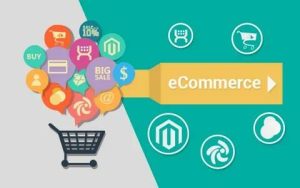Ecommerce, short for electronic commerce, refers to the buying and selling of goods and services over the internet. It involves online transactions and the exchange of information, products, or services between businesses, individuals, or both.
Ecommerce encompasses a wide range of activities, including online retail stores, online marketplaces, digital downloads, online auctions, and electronic payments. It has gained significant popularity and transformed the way people shop and conduct business due to its convenience and accessibility.
Key components of ecommerce include:
- Online Presence: Businesses establish a digital presence through websites, mobile apps, or online platforms where customers can access and interact with their products or services.
- Online Catalog: Ecommerce platforms typically showcase a catalog of products or services, allowing customers to browse and search for specific items.
- Shopping Cart: Customers can add desired items to a virtual shopping cart, which accumulates their selected products for purchase.
- Payment Gateway: Ecommerce platforms integrate secure payment gateways that allow customers to make online payments using various methods, such as credit cards, digital wallets, or bank transfers.
- Order Processing: Once a purchase is made, ecommerce systems handle order processing, including inventory management, order confirmation, and shipping details.
Ecommerce has transformed the retail landscape and provided numerous benefits for businesses and consumers. It offers convenience, access to a wider range of products, competitive pricing, personalized shopping experiences, and the ability to reach global markets. For businesses, ecommerce reduces overhead costs, allows for targeted marketing, and provides valuable data insights.
Online Presence
Online presence is a crucial component of ecommerce. Here are some key aspects of online presence in the context of e-commerce:
- Website: An e-commerce business typically has its own website where customers can access product information, browse through the catalog, and make purchases. The website serves as the online storefront and showcases the products or services offered.
- Mobile App: Many e-commerce businesses also offer dedicated mobile applications to enhance the user experience and cater to customers who prefer shopping on their smartphones or tablets. Mobile apps provide a streamlined and user-friendly interface for browsing and purchasing products.
- User Interface (UI) and User Experience (UX): The design and functionality of an e-commerce website or app play a vital role in attracting and retaining customers. A well-designed UI ensures that users can easily navigate the site, search for products, view product details, and complete transactions seamlessly. A positive UX ensures a smooth and enjoyable shopping experience, leading to customer satisfaction and repeat business.
- Branding and Visual Identity: Online presence allows e-commerce businesses to establish their brand image and visual identity. This includes elements such as a logo, color scheme, typography, and overall design aesthetic that align with the brand’s values and resonate with the target audience.
- Product Descriptions and Imagery: E-commerce websites provide detailed product descriptions, specifications, pricing information, and high-quality images to help customers make informed purchasing decisions. Compelling and accurate product descriptions, along with appealing visuals, are essential for attracting and engaging customers.
Online Catalog
An online catalog is a key component of e-commerce. Here are some important aspects of an online catalog:
- Product Listings: An online catalog includes comprehensive listings of the products or services offered by an e-commerce business. Each product listing typically contains essential information such as the product name, description, price, availability, and any relevant attributes (e.g., size, color, specifications).
- Categorization and Navigation: Products within the online catalog are organized into categories and subcategories, allowing customers to easily browse and locate specific items of interest. Clear and intuitive navigation menus and search functionality help customers find products efficiently.
- Product Images: High-quality product images play a crucial role in showcasing the items in the online catalog. Multiple images from different angles, zoom functionality, and the ability to view product variations (e.g., different colors) provide customers with a visual representation of the products.
- Product Details and Specifications: Each product listing in the online catalog includes detailed information about the item. This may include specifications, dimensions, materials, weight, care instructions, and any other relevant details that help customers understand the product better.
- Pricing and Promotions: The online catalog displays accurate pricing information for each product. It also allows for the display of discounts, promotional offers, bundle deals, or special pricing options to attract customers and encourage purchases.

Shopping Cart
The shopping cart is a fundamental component of e-commerce. Here are some key aspects of the shopping cart:
- Add to Cart Functionality: When customers find https://www.buydo.eu a product they want to purchase, they can add it to their shopping cart. This functionality allows them to accumulate multiple items for purchase before proceeding to checkout.
- Product Quantity and Variations: The shopping cart allows customers to specify the quantity of each item they wish to purchase. If a product has different variations (e.g., size, color), the shopping cart enables customers to select their preferred options.
- Cart Summary: The shopping cart provides a summary of the items added, displaying details such as product names, quantities, prices, and subtotal. Customers can review their selections and make any necessary modifications, such as updating quantities or removing items.
- Price Calculation: The shopping cart calculates the total price of all the items, taking into account any discounts, promotions, or applicable taxes. It provides transparency and clarity regarding the cost of the purchase.
- Save for Later: Some shopping cart functionalities allow customers to save items for later purchase. This feature is useful when customers want to revisit or compare products before making a final decision.
Payment Gateway
Payment gateway is a crucial component of e-commerce. Here are some key aspects of a payment gateway:
- Secure Online Payments: A payment gateway enables secure online transactions by facilitating the transfer of funds from customers to the e-commerce business. It encrypts sensitive payment information (such as credit card details) to ensure the privacy and security of customer data.
- Multiple Payment Options: A payment gateway supports various payment methods, including credit cards, debit cards, digital wallets (such as PayPal, Apple Pay, or Google Pay), bank transfers, and other alternative payment solutions. This allows customers to choose the payment option that is most convenient for them.
- Authorization and Verification: The payment gateway verifies and authorizes the payment by communicating with the customer’s bank or payment provider. It confirms the availability of funds or credit and checks for any potential fraud or security issues.
- Seamless Integration: A payment gateway integrates with the e-commerce platform or website, enabling a smooth and seamless payment process for customers. It ensures that the payment flow is well-integrated into the overall user experience, minimizing any disruptions or friction during the checkout process.
- Payment Gateway Providers: E-commerce businesses typically partner with payment gateway providers, such as Stripe, PayPal, Authorize.Net, or Braintree, to handle the payment processing. These providers offer the necessary infrastructure, security measures, and APIs (Application Programming Interfaces) for integrating the payment gateway into the e-commerce platform.
- Payment Settlement: Once a payment is authorized and processed successfully, the payment gateway facilitates the settlement of funds, transferring the payment from the customer’s account to the e-commerce business’s merchant account. Settlement processes may vary depending on the payment gateway provider and the business’s agreement.
- Security and Fraud Prevention: Payment gateways employ robust security measures, such as encryption, tokenization, and fraud detection tools, to protect against unauthorized access, data breaches, and fraudulent transactions. They help safeguard customer payment information and provide peace of mind for both customers and businesses.
- Transaction Reporting and Analytics: Payment gateways often provide reporting and analytics tools that allow businesses to track and analyze transaction data. This data includes information on successful payments, declined transactions, chargebacks, and other metrics that help businesses monitor their financial performance and optimize their payment processes.
Overall, a payment gateway is a critical component that ensures the secure and efficient processing of online payments, providing customers with a seamless checkout experience and enabling e-commerce businesses to receive payments in a secure and timely manner.
Order Processing
Order processing is a vital component of e-commerce. Here are some key aspects of order processing:
- Order Confirmation: After a customer completes a purchase, the e-commerce platform generates an order confirmation. This confirmation typically includes details such as the order number, purchased items, quantities, prices, shipping address, and billing information. It serves as a receipt and reference for both the customer and the e-commerce business.
- Inventory Management: Order processing involves managing the inventory to ensure that the purchased items are available and ready for shipment. E-commerce platforms track inventory levels in real-time, updating stock quantities as orders are placed and fulfilled.
- Order Fulfillment: Once an order is confirmed, the e-commerce business prepares the items for shipment. This includes picking the products from the inventory, packaging them securely, and generating shipping labels or documentation.
- Shipping and Delivery: The e-commerce platform coordinates the shipping and delivery of the products to the customer’s specified address. This may involve partnering with shipping carriers or logistics providers to ensure timely and reliable delivery. Tracking information is often provided to customers so they can monitor the status of their shipments.
- Order Tracking: E-commerce platforms provide order tracking functionality, allowing customers to monitor the progress of their orders. Customers can access information such as the shipment’s current location, estimated delivery date, and any updates or delays.
- Customer Communication: Throughout the order processing cycle, e-commerce businesses maintain communication with customers. This includes sending order confirmations, shipping notifications, and any updates regarding the status of the order or potential delays. Clear and timely communication helps manage customer expectations and enhances the overall customer experience.
- Returns and Refunds: In the event of product returns or refund requests, the e-commerce platform facilitates the process. This involves managing return policies, providing return instructions, processing refunds, and updating inventory accordingly. Clear return and refund policies contribute to customer satisfaction and trust.
Effective order processing ensures that customer orders are accurately fulfilled, shipped promptly, and delivered in a satisfactory manner. It involves managing inventory, coordinating shipping logistics, maintaining communication with customers, and handling returns and refunds, ultimately contributing to a positive customer experience in e-commerce.
